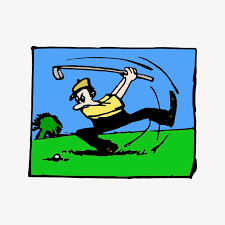Crunch the Numbers: The Importance of Calculating Club Head Speed in Golf
In the game of golf, mastering the art of club head speed can make all the difference between a mediocre swing and a powerful drive down the fairway.
Achieving the optimal club head speed not only increases the distance your ball travels but also enhances control and accuracy in your shots. So, how do you calculate and improve your club head speed?
In this article, we delve into the importance of calculating club head speed in golf and how it can elevate your performance on the course.
By understanding the mechanics behind club head speed, you’ll gain invaluable insights into your swing, enabling you to make the necessary adjustments for better results.
We explore the various methods and equipment available for measuring club head speed, as well as provide tips and exercises to enhance it.
Whether you’re a beginner looking to maximize your potential or an experienced golfer aiming for that extra edge, this article will equip you with the knowledge and tools to take your game to the next level.
Get ready to crunch the numbers and revolutionize your golf game with the power of club head speed!
Why club head speed matters in golf
Club head speed is a crucial factor in golf that can significantly impact your performance on the course. The speed at which your club head moves through the impact zone determines the distance your ball travels and the accuracy of your shots.
The higher the club head speed, the farther the ball will travel, allowing you to reach those unreachable fairways and greens.
Moreover, club head speed affects the spin rate of the ball. A higher club head speed generates more backspin, enabling the ball to stay in the air longer and land softly on the green.
This spin control is essential for precise shot placement, especially when approaching the pin or navigating hazards.
In addition to distance and accuracy, club head speed also influences the feel of your swing. When you generate more speed, you experience a sense of power and control over the club, translating into confidence on the course.
So, if you want to unleash your full potential as a golfer, understanding and improving your club head speed is paramount
The impact of club head speed on distance and accuracy
When it comes to golf, distance and accuracy are two critical elements that every golfer strives to master. Club head speed plays a pivotal role in achieving both of these objectives.
First and foremost, let's focus on distance. The speed at which your club head strikes the ball directly translates into the distance it will travel.
This is due to the principle of the conservation of momentum - the faster the club head, the more momentum it transfers to the ball upon impact.
As a result, the ball soars through the air, covering more ground and potentially surpassing hazards or obstacles.
Accuracy, on the other hand, is affected by the combination of club head speed and the angle of approach. When you swing with an optimal club head speed, you can maintain better control over the club, allowing for a more consistent swing path.
This, in turn, improves the accuracy of your shots, helping you hit the fairway more often and avoid costly mishits.
It's worth noting that while club head speed is crucial, it's not the only factor determining distance and accuracy. Technique, timing, and the fit of your equipment also play significant roles.
However, focusing on improving your club head speed can have a profound impact on your overall performance on the course
How to calculate club head speed in golf
Calculating your club head speed in golf may seem like a complex task, but with the right tools and techniques, it becomes relatively straightforward.
Here are a few methods commonly used by golfers and professionals alike:
1. Launch Monitors: Launch monitors are sophisticated devices that use radar or camera-based technology to measure various aspects of your swing, including club head speed. These devices provide accurate and real-time data, allowing you to track your progress and make necessary adjustments.
2. Swing Speed Radars: Swing speed radars are portable devices that measure club head speed by capturing the time it takes for the club to travel a specific distance. These compact devices are easy to use and provide instant feedback on your swing speed.
3. Golf Simulators: Golf simulators are becoming increasingly popular among golfers looking to practice indoors. These simulators use advanced technology to replicate the golfing experience, including measuring club head speed. By utilizing a golf simulator, you can analyze your swing and improve your club head speed without stepping foot on a real course.
It's important to note that while these methods provide accurate measurements, they may require an investment in equipment or access to a golf facility.
However, there are also apps and smartphone accessories available that claim to measure club head speed, although their accuracy may vary.
Regardless of the method you choose, remember that consistency is key. Measure your club head speed regularly to track your progress and identify areas for improvement
Factors that affect club head speed
Several factors can influence your club head speed in golf. Understanding these factors can help you identify areas for improvement and optimize your swing. Here are some key factors to consider:
1. Technique: Your swing technique plays a crucial role in the speed at which your club head moves through the impact zone. Proper body rotation, weight transfer, and timing are essential for generating maximum club head speed. Working with a golf instructor or coach can help you fine-tune your technique and optimize your swing mechanics.
2. Flexibility and Strength: Flexibility and strength are vital components of generating club head speed. A flexible and strong body allows for a more efficient transfer of energy from your body to the club. Incorporating exercises that target flexibility and strength, such as yoga or weightlifting, can help improve your club head speed.
3. Equipment: The type and fit of your golf clubs can significantly impact your club head speed. Clubs with the correct shaft flex, loft, and weight distribution can optimize your swing and maximize club head speed. Consult with a professional club fitter to ensure your equipment is tailored to your swing characteristics.
4. Grip Pressure: The way you grip the club can influence your club head speed. A grip that is too tight can restrict the natural release of the club, leading to a decrease in speed. Experiment with different grip pressures to find the one that allows for a fluid and unrestricted swing.
By addressing these factors and making any necessary adjustments, you can enhance your club head speed and ultimately improve your performance on the golf course
Tips for increasing club head speed
Now that you understand the importance of club head speed and the factors that affect it, let's explore some tips to help you increase your club head speed:
1. Develop a Strong Core: A strong core is essential for generating power and speed in your swing. Incorporate exercises that target your core muscles, such as planks, rotational exercises, and medicine ball throws, into your fitness routine.
2. Improve Flexibility: Flexibility is crucial for a full and unrestricted swing. Stretching exercises, such as shoulder and hip stretches, can help improve your range of motion and allow for a more efficient swing.
3. Practice Tempo and Timing: Focus on maintaining a smooth and consistent tempo throughout your swing. Avoid rushing or decelerating during the downswing, as this can negatively impact your club head speed. Practice drills that emphasize tempo and timing, such as swinging to a metronome or using a rhythm trainer.
4. Utilize Resistance Training: Incorporate resistance training into your workout routine to build strength and power. Exercises such as medicine ball throws, kettlebell swings, and resistance band exercises can help increase your club head speed.
5. Track Your Progress: Keep a record of your club head speed measurements to track your progress over time. This will not only help you stay motivated but also provide valuable feedback on the effectiveness of your training methods.
Remember, increasing your club head speed takes time and dedication. Be patient with yourself and focus on consistent practice and improvement
The role of technology in measuring club head speed
In today's digital age, technology has revolutionized the way we measure and analyze club head speed in golf. Advanced devices and software have made it easier than ever to track and understand the intricacies of your swing.
Launch monitors, as mentioned earlier, provide comprehensive data on multiple aspects of your swing, including club head speed.
These devices utilize radar or camera-based technology to capture precise measurements, allowing you to analyze your swing in real-time and make data-driven adjustments.
Additionally, golf simulators offer a virtual environment that not only measures club head speed but also provides feedback on other crucial aspects of your swing, such as launch angle and ball spin rate.
By utilizing these simulators, golfers can practice and improve their club head speed in a controlled and immersive environment.
Mobile apps and smartphone accessories have also entered the market, claiming to measure club head speed. While these options may be more accessible and affordable, their accuracy and reliability may vary.
It's important to research and read reviews before relying on such tools for precise measurements.
Overall, technology has empowered golfers with valuable insights into their swing mechanics and club head speed.
By leveraging these technological advancements, you can gain a deeper understanding of your swing and make informed decisions to improve your performance.
Common misconceptions about club head speed
As with any aspect of golf, there are several misconceptions surrounding club head speed. Let's debunk some of the most common ones:
1. Faster is Always Better: While increased club head speed can lead to longer drives, it's not the only factor determining distance and accuracy. Your swing technique, timing, and other factors also play crucial roles. It's important to find the right balance between speed and control for optimal performance.
2. Only Professionals Can Achieve High Club Head Speed: Club head speed is not exclusive to professional golfers. By focusing on improving your technique, strength, and flexibility, golfers of all levels can increase their club head speed and enhance their performance.
3. Club Head Speed is Fixed: Club head speed is not a fixed attribute that remains constant throughout your golfing journey. With proper training, practice, and adjustments, you can improve your club head speed over time.
4. Club Head Speed is the Sole Determinant of Success: While club head speed is important, it's not the only factor that determines success in golf. Accuracy, course management, and mental fortitude also contribute to a golfer's overall performance. Focus on developing a well-rounded skill set rather than solely relying on club head speed.
By dispelling these misconceptions, you can approach club head speed with a more balanced and informed perspective, leading to better results on the course.br/>
Training exercises to improve club head speed
To enhance your club head speed, incorporating specific training exercises into your routine is essential. Here are a few exercises that can help you increase your speed and power:
1. Medicine Ball Throws: Stand with your feet shoulder-width apart and hold a medicine ball with both hands. Rotate your torso to one side, then explosively throw the ball forward as if you were hitting a golf shot. Repeat on the other side. This exercise helps develop rotational power, which translates into increased club head speed.
2. Kettlebell Swings: Stand with your feet slightly wider than shoulder-width apart and hold a kettlebell with both hands between your legs. Bend at the hips and knees, then explosively swing the kettlebell up to chest level by extending your hips and driving your glutes forward. This exercise targets your core and glute muscles, which are crucial for generating power in your swing.
3. Resistance Band Exercises: Attach a resistance band to a sturdy anchor point and hold the other end with both hands. Assume your golf setup position and rotate your torso away from the anchor point, keeping your arms extended. Return to the starting position and repeat on the other side. This exercise strengthens your rotational muscles and improves your range of motion.
4. Plyometric Exercises: Incorporate plyometric exercises, such as box jumps or lateral bounds, into your training routine. These explosive movements help improve your fast-twitch muscle fibers, which are responsible for generating power and speed.
Remember to consult with a fitness professional or golf instructor before incorporating these exercises into your routine. They can provide guidance on proper form and technique to prevent injury and maximize results.


